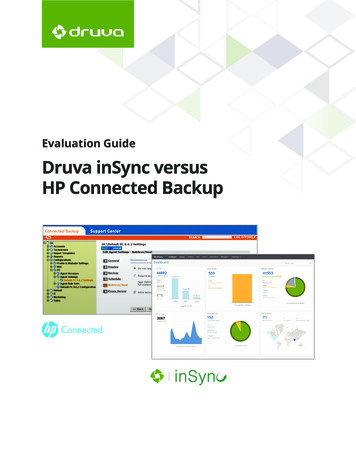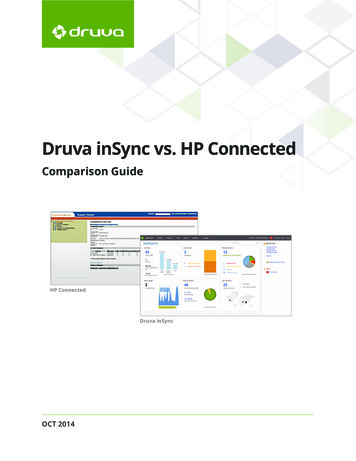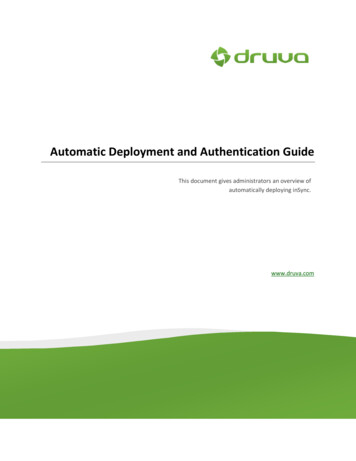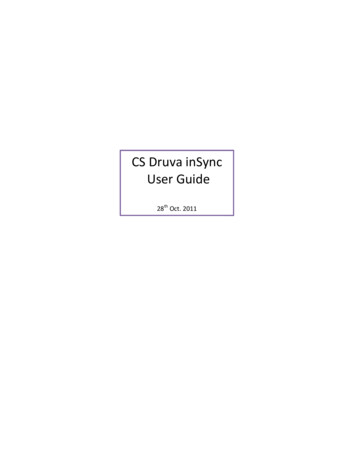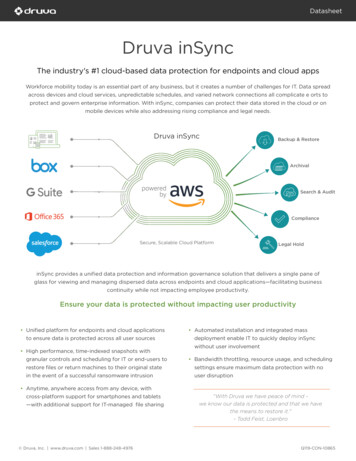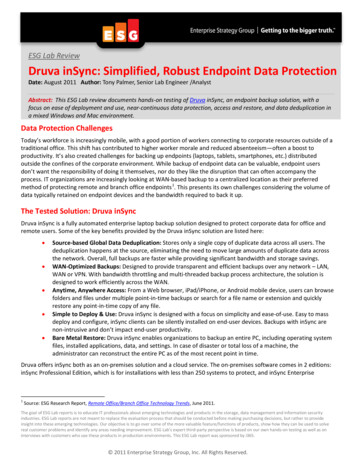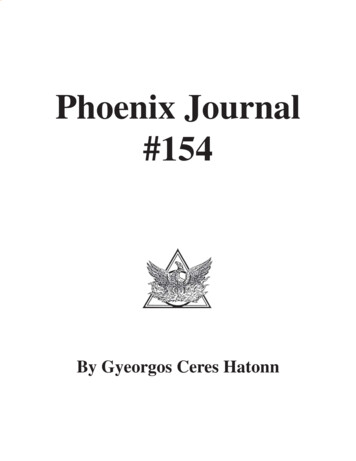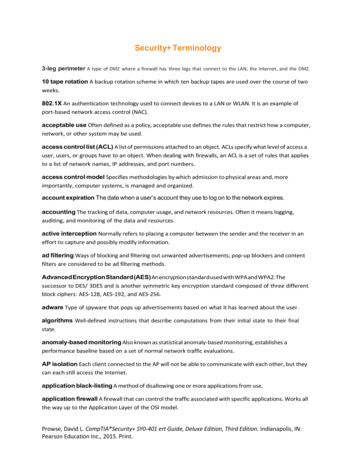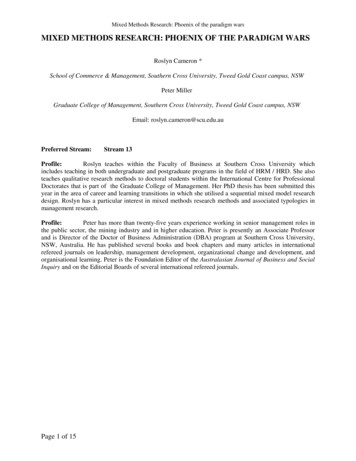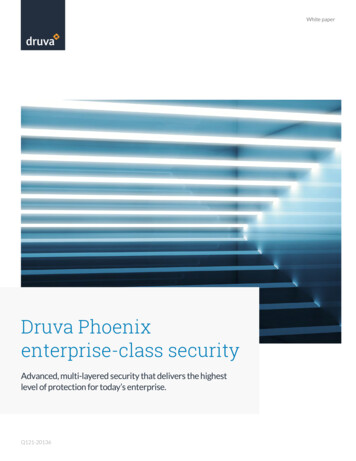
Transcription
White paperDruva Phoenixenterprise-class securityAdvanced, multi-layered security that delivers the highestlevel of protection for today’s enterprise.Q121-20136
Executive summaryDruva keeps enterprise data secure from end to end by adhering to proven standards that protect your data’s privacy andsafeguard it from external threats. Developed with security as a foundational cornerstone, Druva’s solutions are engineeredto ensure data security at every step — transmission, storage, and access.This document is designed to provide a detailed review of the security guidelines and measures Druva has put in place to protectcustomer data. As will be shown, Druva takes a multifaceted approach to data security that extends far beyond basic encryption.Druva Phoenix overviewDelivered as-a-service, Druva Phoenix combines high-performance, scalable all-in-one backup, disaster recovery (DR),archival, and analytics to simplify data protection, dramatically reduce costs, and improve data visibility for today’s complexinformation environments.VMware Cloud onAWS (VMC)LinuxAt Disaster TimeDruva Cloud PlatformDR ProxyAmazon EBSSnapshotAmazon EC2Customer AWS VPCVM(vSphere,Hyper-V)NAS(CIFS/SMB)Data CenterBy leveraging cloud-native technologies, Druva Phoenix removes the traditional bottlenecks of computing and scale, deliveringa high-performance cloud platform that enables organizations to replace on-premises solutions and still meet or exceed theirRPO and RTO targets.Druva Cloud Platform overviewThe Druva Cloud Platform is a fully-automated, enterprise-class data protection solution powered by Amazon Web Services (AWS)technology. It offers elastic compute and on-demand storage that can grow to accommodate any number of users and data.In addition, the Druva Cloud Platform can be instantly provisioned to a global-user base with policies that lock user storageto specific AWS regions.The Druva Cloud Platform provides secure, lightning-fast backup and restores and operates in 14 AWS regions around the worldto address the needs of global enterprises. It delivers high availability and is built on an enterprise-class infrastructure that iscompliant with international standards such as ISO-27001, SOC-1, SOC-2, and SOC-3.Additionally, to ensure the utmost security confidence for enterprises, Druva itself has been SOC-2 and HIPAA auditedand conducts quarterly vulnerability scans and annual third-party penetration tests. Druva www.druva.com2
Full administrative control of Druva Phoenix is provided via a secure, web-based administrator control panel over HTTPS, whichallows corporate policies to be defined for servers. Druva Phoenix supports Role-Based Access Control (RBAC) that allows fordelegated administration. This enables organizations to implement separation of duties within their specific management domainand without access or visibility into the management domains of other organizations in an enterprise.On the client side, a lightweight agent manages backup and source-side deduplication. Provisioning is a two-step process that iseasily scripted for mass deployment scenarios.Druva Cloud Platform securityIn order to thoroughly secure customer information in the cloud, Druva implements a multi-tiered security model. The componentsof that security model are defined in this section.Secure multi-tenancyThe Druva Cloud Platform provides a secure, multi-tenant environment for customer data, thereby resulting in a virtual privatecloud for each customer.This secure multi-tenancy is realized by: Logical segmentation of customer records Customer data encryption using a unique per tenant AES-256 encryption keyData in flightDruva is designed from the ground up with the understanding that servers often connect over WANs and VPN-less networks forbackup activities. The Druva Cloud Platform service encrypts data in transit with 256-bit TLS 1.2 encryption by default, ensuringenterprise-grade security over these networks.Data at restIn addition to strict authentication and access controls, Druva secures data in storage with 256-bit AES encryption. A unique AES256-bit data encryption key is used for each customer account. Druva has implemented an envelope encryption mechanism toencrypt the data encryption key when stored using a customer held key encryption key. The use of one unique encryption key percustomer along with customer held key encryption keys, creates crypto-segmentation between customers, completely avoidingdata leakage.Network securityAbove and beyond the security mechanism that Druva provides as part of the Druva Phoenix SaaS offering, the AWS networkprovides significant protection against network security issues, including (but not limited to): Distributed denial-of-service (DDoS) attacks Man-in-the-middle (MITM) attacks IP spoofing Port scanning Packet sniffing by other tenantsFor details on the security provided by Amazon Web Services, visit www.aws.amazon.com/security/. Druva www.druva.com3
Druva Phoenix architectureThis diagram shows an overview of the architecture of the Druva Phoenix solution, including its security capabilities:Druva Cloud PlatformVPCAuthentication ServicesCustomer Infrastructure On-PremisesLINUXAmazon IFS/SMB)VM(Vsphere, Hyper-V)Backup/RestoreStorage Nodes(optional)Warm Storage 0-90 DaysDeduplicated &Encrypted BlocksIntelligent tiering forLong-term retention(LTR) - optionalDataAmazon S3AWS DirectConnectHot:0-30 Days(Deduped,secured)Amazon S3 GlacierDeep ArchiveDisaster Recovery as a ServiceVPCTLSVMware, AHV, Hyper-VCustomer-ownedAmazon Virtual Private Cloud (VPC)GatewayFailbackIAM RolesIAM PoliciesDruva Phoenix architecture componentsDruva Phoenix is comprised of multiple components that, when combined, provide complete protection of customer information.Those components are as follows:Amazon Web ServicesThe Druva Cloud Platform, where the Druva Phoenix SaaS application resides, is built on top of the AWS technology stack.Amazon is a world leader in designing, constructing, and operating large-scale data centers throughout the world. The only peoplewho know the actual locations of these centers are those within Amazon with a legitimate business need to have the information.The data centers themselves are secure and meet ISO-27001, SOC-1, SOC-2, and SOC-3 certification requirements.CloudCacheDruva CloudCache is a local cache designed to help customers meet stringent recovery point objectives (RPOs) and recovery timeobjectives (RTO) that cannot be met directly by the Druva Cloud. It is delivered as a virtual appliance and stores data from DruvaPhoenix agents, then periodically synchronizes this data to the Druva Cloud. It is deployed as a VM on any customer infrastructureon-premises in a data center or other location. If customer bandwidth to AWS is limited or the data set too large to meet RTOfrom the cloud, CloudCache provides LAN speeds for both backup and recovery operations. CloudCache can deliver scheduledcloud sync to meet tight RTO/RPO needs while allowing customers to control when replication to the Druva cloud occurs. Withits flexible scheduling and cache controls, CloudCache retains hot snapshots (up to 30 days) on-premises, while efficiently utilizingyour WAN bandwidth to the cloud. Druva www.druva.com4
Single sign-onDruva Phoenix supports SAML, an XML-based open standard for exchanging authentication and authorization data betweensecurity domains. SAML permits users to securely log into Phoenix using their credentials on external identity services such asMicrosoft Active Directory Federation Services, Microsoft Azure AD, and other third-party providers like Okta and OneLogin.IDPWeb app 1UserSSO(1) User send cred(2) User gets authenticated by IDPWeb app 2(3) IDP authenticates with DruvaIDP: Identity Provider Services (e.g. Okta, OneLogin, Ping One, Azure AD, etc.)Server agentsDruva Phoenix provides efficient backup of server data directly to the cloud, as well as cloud-based Disaster Recovery (DR)for virtual environments. Effectively protecting server data requires smart integration with multiple structured and unstructureddata sources. Druva Phoenix provides the following agents for heterogeneous server environments: VMware Virtual Machines Microsoft Hyper-V Virtual Machines Microsoft Windows File and Application Servers Linux File and Application Servers Microsoft SQL Servers Oracle Databases Network Attached Storage (NAS)Data encryptionA key attribute of any cloud service is to be able to secure data both “in-flight” and “at rest.” All data that Druva sends tothe cloud is protected in-flight to AWS using industry standard, Transport Layer Security (TLS 1.2). Data at rest, whether it isstored on-premises with the customer in the Druva Phoenix CloudCache or in the Druva Cloud, is protected with AES-256encryption. The following is an in-depth look at the Druva Encryption Architecture. Druva www.druva.com5
Encryption overviewOnce the data arrives in the Druva Cloud Platform at the predefined regional storage node over a TLS 1.2 connection, it isimmediately encrypted using an AES 256-bit encryption key that is unique to, and completely controlled by, that customer.The following diagram illustrates the encryption flow:Data arrives to Druva cloudand is encrypted using AES-265Data sourceswith Druva agentNAS*VM*AES-256Data in flightTLSServers*Via proxy serverDruva has no access to this encryption key or customer data. This unique encryption key per customer guarantees that in additionto the logical separation, there is an additional layer of access control that prevents data leakage in the cloud for data at rest. Thiscustomer encryption key is a session-only key algorithm modeled on digital envelope encryption. The result is that the customerkey is only held in memory and never stored unencrypted, transferred or accessible from outside a user’s active cloud-side session,removing the need for expensive and complex key management solutions.Digital envelope encryptionTo uphold the highest security standards for enterprises, encryptionkey management in the Druva Cloud Platform is modeled after digitalKey encryption keyenvelope encryption. Digital envelope encryption is the defaultstandard for cloud encryption, and is comprised of two encryptionkeys, as seen in the following diagram:Data encryption keyThe first key is the Data Encryption Key (DEK), which is used toencrypt customer data in the form of unique data blocks stored inAWS S3. This key is a randomly generated AES 256-bit encryptionkey that is unique to that individual customer. The DEK is only heldunencrypted in memory within the Druva Cloud Platform for usewith cryptographic operations I/O operations. At no time is the DEK exposed in plain text form via WebUI or CLI to eitherthe customer or Druva personnel. Additionally, Druva has strict logical access controls to prevent access to production backupnodes. No Druva personnel have direct (SSH) access to servers processing backup operations.The DEK is generated at the time of the creation of the customer instance in the Druva Cloud Platform and stored as an encryptedtoken in an AWS RDS database. The process for the creation of the DEK and token is as follows:1. Upon the creation of a new cloud instance, three things take place:a. A randomly generated AES 256-bit encryption is generated (DEK)b. An 11-character complex password is generated and delivered to the customer administrator (P1)c. Random salt is generated (S1) Druva www.druva.com6
2. These three pieces of data are then concatenated (S1 DEK P1)3. This concatenation is then AES 256-bit-encrypted with the SHA2 of the randomly generated password (P1)in a Password-Based Key Derivation Function (PBKDF). This creates the first cloud admin token (AT1).4. The token is then stored in the RDS database, while the password is held by the administratorFor additional security, the RDS database where the token is stored is also encrypted using AES-256. At no time is the actualdata encryption key saved by the server; it exists only at the time a server or admin is authenticated, used in working memoryfor the duration of the session, and is then destroyed.The second key is the Key Encryption Key (KEK), also commonly referred to as a Key Wrapping Key (KWK) in the cryptographycommunity. The KEK places the DEK in an encrypted envelope when it is stored as a token in the Druva Cloud Platform. The KEKis generated using a Password-Based Key Derivation Function (PBKDF) by taking the user password or device key, running itthrough an SHA-256 hash function, which then generates the KEK. This KEK is then used to encrypt the token as described earlierin this section.At no time is the actual DEK saved by the server; it exists only at the time a server or admin is authenticated, used in workingmemory for the duration of the session, and is then destroyed.This strict key management mechanism ensures that: Druva NEVER has access to your data. If required to present your data to a third party (for example, the federalgovernment), we CANNOT do so. Druva CANNOT reset your password. Because the admin password is needed to construct the key required to decryptthe data, we require that the user set up multiple administrators. If a password is forgotten by any of the administrators,one of the other administrators in the organization can reset it. Druva CANNOT do so.Data shardingIn addition to digital envelope encryption, an additional layer of security is derived from Druva’s patented deduplicationtechnology, where files are split into individual blocks and only unique blocks are sent to the service globally across all devices.These unique blocks are stored in object storage without any identifying metadata, while block reference data and associatedsource file metadata are stored in a separate, object-based NoSQL database—completely obfuscating the underlying data.Reconstitution of data is only possible through authenticated customer credentials which are required to instantiate the sessionbased key mechanism.The result of this encryption of unique blocks is that the data is sharded, scrambled, and stored within the environment in a mannerthat makes it impossible for someone to decrypt and reassemble the information without authenticated customer credentials.CloudCache encryptionDruva CloudCache is a local cache designed to help customers meet stringent recovery point objectives (RPOs) and recoverytime objectives (RTO) that cannot be met directly by the Druva Cloud. It is delivered as a virtual appliance and stores data fromDruva Phoenix agents, then periodically synchronizes this data to the Druva Cloud. While this virtual appliance lives on-premiseswith the customer, the need to secure customer information is just as great as it is in the cloud environment.Druva CloudCache encrypts data using AES 256-bit encryption. This encryption key is a different Data Encryption Key (DEK)than the key used to store data in the Druva Cloud.Operational securityDruva employees have no access to any of a customers’ instances. Access to cloud infrastructure by Druva employees is limited toits cloud operations team and follows strict rules and regulations defined under the Druva security policies document. This accessis granted to enable the successful completion of security patching, service upgrades, and monitoring tasks. Druva www.druva.com7
Business continuityBuilt-in clusters across a variety of global regions, AWS data centers are designed to anticipate and tolerate failure whilemaintaining service levels. The Druva Cloud Platform provides multi-zone replication of various elements of customer dataincluding configuration, metadata, and the actual data—thereby ensuring that customer data is accessible from multiple availabilityzones, to mitigate the failure of any single zone.Third-party certificationsWe’re proud of the third-party validation that supports the trustworthiness of our security—one of our core pillars. While manycloud SaaS vendors simply rely on the certifications that the CSPs provide for the infrastructure as their security model, Druvahas gone above and beyond, achieving compliance and attestations for our cloud service. To date, Druva is certified or can claimcompliance with the following certifications and frameworks, including (but not limited to): SOC 2 type II audited HIPAA compliance FIPS 140-2 compliant (GovCloud environments)Phoenix (SaaS) application(SaaS) Application Services(PaaS) Distributed Database Services(IaaS) Infrastructure: Compute StorageThese certifications are available from Druva upon request.Sales: 1 888-248-4976 sales@druva.comAmericas: 1 888-248-4976Europe: 44 (0) 20-3750-9440India: 91 (0) 20 6726-3300Japan: 81-3-6890-8667Singapore: 65 3158-4985Australia: 61 1300-312-729Druva delivers data protection and management for the cloudera. Druva Cloud Platform is built on AWS and offered as-a-Service;customers drive down costs by up to 50 percent by freeing themselvesfrom the burden of unnecessary hardware, capacity planning, andsoftware management. Druva is trusted worldwide by over 4,000companies at the forefront of embracing cloud. Druva is a privatelyheld company headquartered in Sunnyvale, California and is fundedby Sequoia Capital, Tenaya Capital, Riverwood Capital, Viking GlobalInvestors, and Nexus Partners. Visit Druva and follow us @druvainc. Druva, Inc. www.druva.com
Druva keeps enterprise data completely secure from end to end by adhering to proven standards that . On the client side, the device agent is a lightweight, non-intrusive application that manages data backup . SAML permits
